|
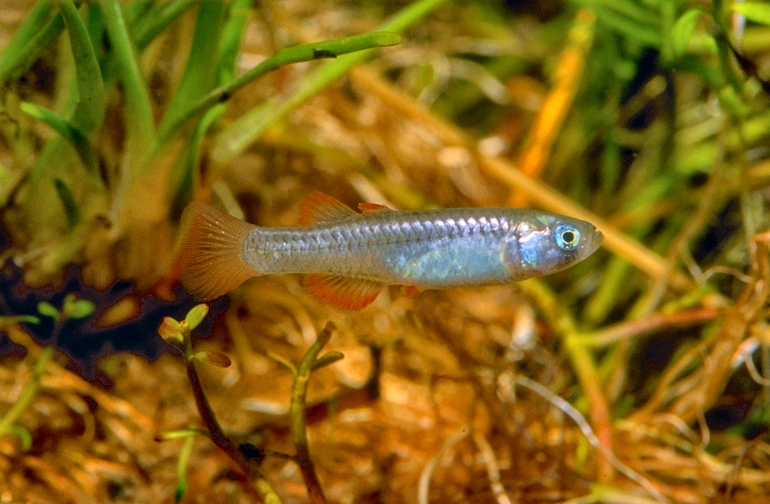 |
Scaturiginichthys vermeilipinnis - photo© Gunther Schmida |
Ivantsoff, Unmack, Saeed and Crowley, 1991
Redfin Blue Eye
Species Summary
Scaturiginichthys vermeilipinnis were originally collected from a number of artesian springs located on Edgbaston Station, a sheep and cattle property located 35 km north-east of Aramac in central-western Queensland in 1990, and were scientifically described in 1991. The scientific name is a reference to the unique habitat (scaturginis is Latin for spring; ichthys, pertaining to a fish) and the red colouration on the margins of the dorsal and anal fins (vermeil - old French red or vermilion; pinnis, Latin for fins).
Scaturiginichthys vermeilipinnis is Australia's smallest freshwater fish reaching a maximum total length of around 28 mm. They have a translucent silvery to golden body that becomes darker dorsally and around the head region with a plainly visible swim bladder. Iridescent scales are visible above the anterior midlateral line. Opercles iridescent; eyes silvery-blue with a dark vertical stripe through the orbit. The males' unpaired and pelvic fins are edged with red, hence their common name of Redfin Blue Eye. Fins are clear to faintly yellowish in juveniles and females. Juveniles have the posterior half of the body golden-yellow. Males are generally larger than females with larger fins. External morphology separating S. vermeilipinnis from other blue-eyes include a narrow rounded caudal fin, lower position of the pectoral fin and frequent absence of ventral fins which may be an adaptation to a very shallow habitat.
Scaturiginichthys vermeilipinnis is Australia's most endangered freshwater fish and share their habitat with another endangered species Chlamydogobius squamigenus, the Edgbaston Goby. Although population numbers in individual springs have varied since their discovery, specific population trends are not well known and they have disappeared completely from a number of springs. It is estimated that their numbers may range from a few hundred to a few thousand individuals. Their continued existence is being threatened by the introduced mosquitofish Gambusia holbrooki and habitat destruction caused by harvesting water from the Great Artesian Basin; trampling and grazing by stock and feral animals, and modification of springs to provide for stock watering. The Great Artesian Basin Bore Rehabilitation Program may have some long-term benefits in terms of increased water flow to the springs. Bores are been capped and drainage canals are being replaced with pipes to reverse declining groundwater pressures and water levels; this has led to the restoration of some spring wetlands.
The fragile nature of the springs at Edgbaston implies that extinction of these truly unique features of the arid Australia landscape and the associated aquatic fauna is very real. A recent survey has found that sub-populations of this species are not healthy and potential threats are increasing.
Scaturiginichthys vermeilipinnis was originally recorded as naturally occurring in eight separate springs. Since its discovery in 1990, five populations have been lost and subsequent colonisation has occurred in two springs. In 1994 five naturally occurring populations were known, plus a translocated population (from one of the above springs). A 'Species Recovery Plan' was prepared for the Australian Nature Conservation Agency (now Environment Australia) in 1995, although it was generally not implemented. When the springs were visited in 1998 the five springs still contained existing populations. A survey in 2005 found that the redfins were present in five relatively small shallow springs. They appeared to have become extinct from three of the larger deeper springs. The cause of their demise has not been clearly established.
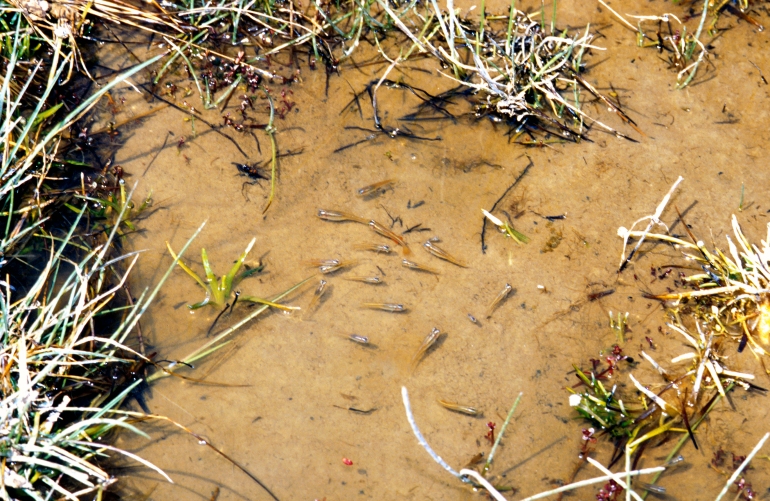 |
Natural Springs Habitat - photo© Gunther Schmida |
Distribution & Habitat
Scaturiginichthys vermeilipinnis are endemic to the Edgbaston Springs complex near Aramac, which is located 67 km north of Barcaldine (about 930 km west-northwest of Brisbane). Aramac is one of those tiny little settlements in western Queensland which has outlived its original purpose and now stands forlornly in the middle of nowhere supporting the surrounding pastoral properties and sustaining the few people (approx. 300) who continue to live in this inhospitable, hot and dry environment.
Edgbaston Springs are located in the upper reaches of Pelican Creek within the Thomson River system in the Lake Eyre drainage about 31 km north-east of Aramac. Pelican Creek is ephemeral although some waterholes may persist between rainfall events. Pelican Creek (35 km) merges with Aramac Creek. Aramac Creek flows through Boundary Waterhole and Middle Waterhole on its way to joining the Thomson River. The following creeks flow into the Aramac Creek: Curlew Creek, New Year Creek, Emu Hills Creek, Gum Creek, Sandy Creek, Pelican Creek, Politic Creek, Ibis Creek, Corinda Creek, Middle Creek, Willoughby Creek, Four Mile Creek, Langharne Creek, Mountain Creek, Tommlins Creek, Tuaburra Creek, Rodney Creek, Scarrbury Creek, Neil Creek and Gambling Creek.
Edgbaston Springs are a complex of artesian springs scattered across an alluvial plain and supporting an unusual habitat type, which is distinct from the surrounding arid region. The actually wetland area is small; the total surface area of known habitat varies seasonally between approximately 6 to 8 km². At least 44 springs have been identified at Edgbaston Springs, but only about 30 have permanent water, some of which have become extinct. They are derived from faults allowing water to flow from thin confining beds of the Great Artesian Basin aquifer. They are permanent artesian springs, with some evaporation and associated reduction in extent during the summer months. Most of the springs are very small, shallow, and marshy. Some springs lower in the catchment are occasionally connected by floodwater. The structure of wetland vegetation varies, from dense low mats composed primarily of sedges and herbs, to varying densities of tussock grasses. Average cover of wetland vegetation throughout a spring is in the order of 60% with most of the remaining area exposed water (Fairfax pers. comm. 2005).
Water depth varies throughout the springs with depths between 3 and 7 cm. Some springs have associated pools which are usually less than 20 cm deep but may be up to 50 cm. Temperatures recorded in the region show an average high of 29-30°C, average low of 14-16°C. Temperature extremes have been recorded of -3°C and 51°C. Annual rainfall average is 117-161 mm, with a recorded high extreme of 543 mm and a low of 30 mm. Water chemistry of the springs have been reported as follows: Conductivity 560-3270 mS/cm; TDS 478-2597 mg/L; pH 7.1-9.1; Alkalinity 235-1380 mg/L.
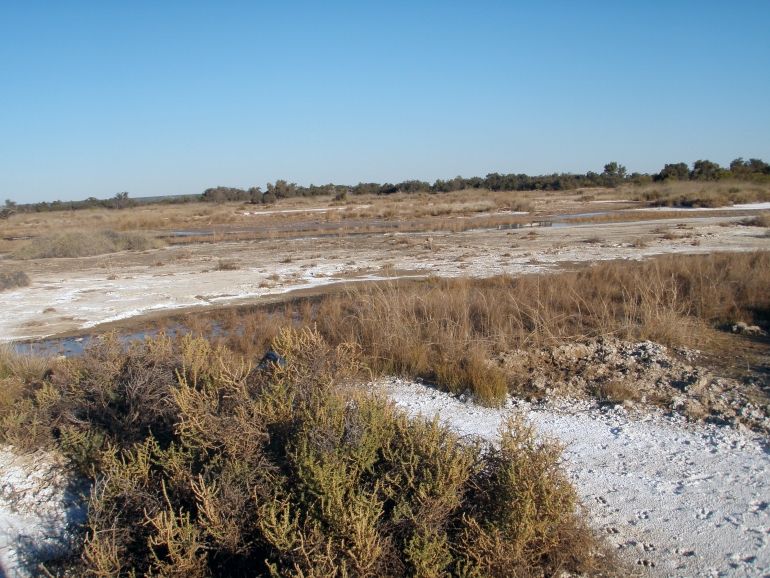 |
Edgbaston Spring habitat - photo© DERM |
The water of the springs that contain S. vermeilipinnis is generally clear with a pH 7.8 to 8.0 (average 7.93) with high alkalinity. Water temperatures are extremely variable from spring to spring and within each spring. In May 1990 the temperatures varied from 7 to 28° Celsius. During May 1991 at 7.00 am water temperatures of 7 to 20°C were recorded in different parts of the springs. While at other times of the year minimum and maximum water temperatures of 3 and 38.5°C have been recorded. S. vermeilipinnis are usually located in areas of the springs where the temperature is above 16°C.
Scaturiginichthys vermeilipinnis may be found throughout all areas of a spring. Adults generally occur in the deeper areas of the springs, while newly hatched fry and juveniles are usually found in the shallower areas. When approached they form large schools, which is probably a predator avoidance response. If undisturbed the fish disperse into smaller groups, and begin feeding and displaying.
Edgbaston Springs contains a diverse endemic fauna (fishes, invertebrates) which rivals that of Dalhousie Springs. Increasing evidence of extraordinary endemism in some groups (especially molluscs and crustaceans) shows that many taxa are confined to single springs or groups of springs. Plant communities include Eryngium fontanum, Sporobolus pamelae, Fimbristylis dichotoma, Utricularia, and Eriocaulon carsonii. The spring's distinctive fauna suggests they have been isolated for a very long time.
Scaturiginichthys vermeilipinnis may have had a much wider distribution in other artesian springs throughout the Lake Eyre region at one time.
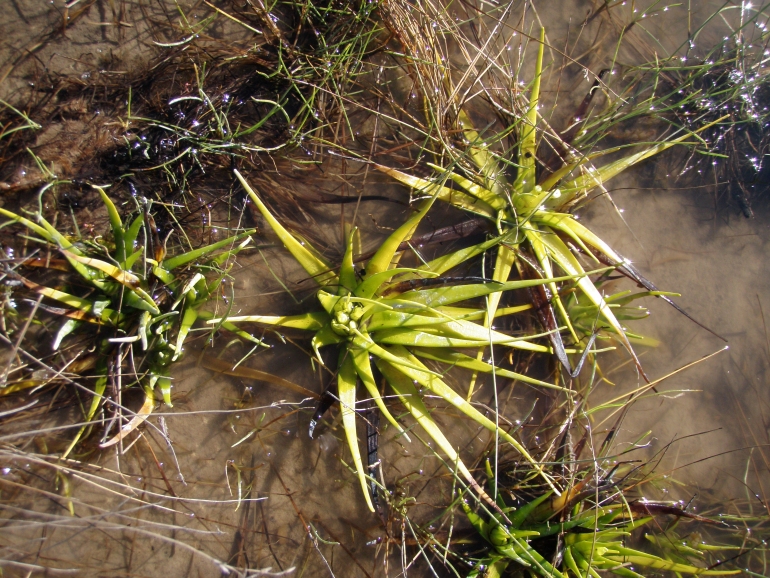 |
Edgbaston Spring habitat - photo© DERM |
Remarks
Edgbaston Station was purchased in 2008 by Bush Heritage Australia. Management of the property in order to conserve endemic fish and other species within the springs is the primary goal of Bush Heritage Australia, and this goal is also supported by the regional natural resource management agency for the Queensland Lake Eyre Basin, Desert Channels Queensland and by the Queensland Department of Environment and Resource Management. Currently, many of the springs are also inhabited by the noxious invasive fish species, Gambusia holbrooki. Vertebrate pests such as feral pigs, goats and domestic stock are also present at Edgbaston, as are introduced plants species.
A fish audit of all springs at Edgbaston was undertaken in March 2009. A total of 93 springs were surveyed, including a number (approx. 15) not recorded in previous surveys. Fish were found in 29 springs, and also in ephemeral creeks fed by run-off from recent rainfall. Gambusia were the most widely distributed and abundant species and occurred in 23 springs. Chlamydogobius squamigenus were found in 9 springs, Scaturiginichthys vermeilipinnis in 4 springs and Leiopotherapon unicolor in 2 springs.
Surveys of the fish fauna within the springs at Edgbaston have been undertaken since November 1990 and indicate that populations of S. vermeilipinnis are declining. As an example, S. vermeilipinnis were found to naturally occur in 6 springs in 1994, whereas this had declined to 4 springs by September 2006. The impact of gambusia has been associated with the decline of S. vermeilipinnis, as this species has increased in number and distribution at Edgbaston during the same period. Current population estimates and distribution of C. squamigenus can be considered incomplete; however this species was present in 8 springs in 1994.
Scaturiginichthys vermeilipinnis were absent from all springs in the southern section of the Edgbaston complex in March 2009. In all springs where fish were present in the southern springs, gambusia was present in large numbers. Chlamydogobius squamigenus were found in two springs in the southern section, and in both instances co-existed with large numbers of gambusia. The southern section included the only areas (2) where Leiopotherapon unicolor were found in artesian springs at Edgbaston.
Scaturiginichthys vermeilipinnis were found in four springs in the northern section of the Edgbaston complex in March 2009, with a comparatively large population present at NW30 and diminishing numbers present at NW90n, NW90s and NW70 respectively. Robust populations of Chlamydogobius squamigenus were found in the same springs and from NW80, where this was the only fish species present. In all other northern springs where fish were present, gambusia was the only species sampled, and all gambusia populations except NE10 were estimated to exceed 1000 individuals.
Scaturiginichthys vermeilipinnis were absent from all springs in the central section of the Edgbaston complex in March 2009. Chlamydogobius squamigenus were found in two springs, and in both instances this was the only fish species sampled. Gambusia were present in five springs in the central section of the Edgbaston complex in March 2009.
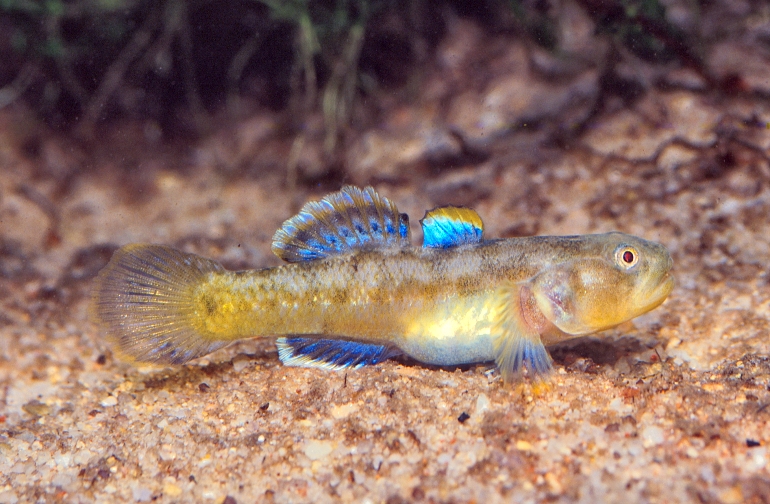 |
Chlamydogobius squamigenus - photo© Gunther Schmida |
Scaturiginichthys vermeilipinnis currently has a limited distribution at Edgbaston and is restricted to four springs in the northern section of the spring complex. The distribution of this species continues to decline compared with results recorded during prior surveys in 1994 and 2007. In particular, this species appears to have disappeared from all springs in the southern and north-eastern sections of the spring complex.
A relocation program for S. vermeilipinnis was commenced in April 2009. A total of 20 individual per spring were relocated to four springs that were uninhabited by fish. Springs were chosen on the basis of their isolation (and hence reduced likelihood of gambusia colonisation). All relocated populations were alive when monitored in May, June, July, August and September 2009, however meaningful results from this relocation event cannot be realistically expected until after summer 2009/10, when rain events and drying events are both most likely. As the project aims to remove gambusia and reintroduce endemic fish species, these relocations are being undertaken in order to trial the survivorship of S. vermeilipinnis populations in different spring environments and simultaneously increase the number of populations at Edgbaston.
Currently, fish-vacant springs are the only sites where endemic fish can be relocated at Edgbaston. Most fish-present springs support large populations of gambusia, and only seven springs support a wholly endemic fish fauna. Although it is possible that relocating S. vermeilipinnis to springs that currently do not support fish may have a deleterious impact on spring invertebrates, accurate data relating to the presence and distribution of spring invertebrates is lacking. At present, increasing the distributional range of S. vermeilipinnis is a higher priority than maintaining fish-vacant springs for the potential benefit of other spring biota (Kerezsy 2009).
Literature
Fairfax R., R. Fensham, R. Wager, S. Brooks, A. Webb and P. Unmack (2007) Recovery of the red-finned blue-eye: an endangered fish from springs of the Great Artesian Basin. Wildlife Research 34: 156-166.
Fensham R.J., R.J. Fairfax and P.R. Sharpe (2004) Spring wetlands in seasonally arid Queensland: floristics, environmental relations, classification and conservation values. Australian Journal of Botany 52: 583-595.
Fensham R., W. Ponder and R. Fairfax (2007) Recovery plan for the community of native species dependent on natural discharge of groundwater from the Great Artesian Basin. Report to Department of the Environment, Water, Heritage and the Arts, Canberra. Queensland Parks and Wildlife Service, Brisbane.
Fensham R.J, W.F. Ponder and R.J. Fairfax (2010) Recovery plan for the community of native species dependent on natural discharge of groundwater from the Great Artesian Basin. Report to Department of the Environment, Water, Heritage and the Arts, Canberra. Queensland Department of Environment and Resource Management, Brisbane.
Ivantsoff W., P. Unmack, B. Saeed and L.E.L.M. Crowley (1991) A red-finned blue-eye, a new species and genus of the family Pseudomugilidae from central western Queensland. Fishes of Sahul 6(4): 277-282
Kerezsy A. (2009) Gambusia control in spring wetlands. South Australian Arid Lands Natural Resources Management Board.
Kerezsy A. & R. Fensham (2013) Conservation of the endangered red-finned blue-eye, Scaturiginichthys vermeilipinnis, and control of alien eastern gambusia, Gambusia holbrooki, in a spring wetland complex. Marine and Freshwater Research 64: 851-863.
Nicol S., T. B. Haynes, R. Fensham and A. Kerezsy (2015) Quantifying the impact of Gambusia holbrooki on the extinction risk of the critically endangered red-finned blue-eye. Ecosphere 6(3):41.
Tappin A.R. (1995) Redfinned Blue-eye. Fishes of Sahul 9(3): 430-432.
Tappin A.R. (1995) On the Eve of Extinction. Practical Aquariums and Watergardens 10: 18-19.
Tappin A.R. (1995) Das Rotflossige Blauauge: Scaturiginichthys vermeilipinnis. Regenbogenfisch 10(2): 30-35.
Tappin A.R. (2011) Rainbowfishes - Their Care & Keeping in Captivity. Art Publications, Australia.
Unmack P.J & C. Brumley (1991) Initial observations on spawning and conservation status of redfinned blue-eye (Scaturiginichthys vermeilipinnis) Fishes of Sahul 6(4): 282-284
Unmack P.J. (1992) Further observations on the redfinned blue eye's conservation status in ANGFA Bulletin 12: 8-9
Unmack P.J. (1995) Desert fishes down under in Proceedings of the Desert Fishes Council, 1994 Symposium 26: 71-95.
Wager R. & P. Jackson (1993) The Action Plan for Australian Freshwater Fishes. Australian Nature Conservation Agency. Canberra, ACT.
Wager R. (1994) The Distribution of Two Endangered Fish in Queensland, Part B, The Distribution and Status of the Red-finned Blue-eye. Final Report to the Australian Nature Conservation Agency, Canberra.
Wager R. (1995) Recovery Plan for Queensland Artesian Spring Fishes. Australian Nature Conservation Agency, Canberra.
Adrian R. Tappin
Updated September, 2015



|

